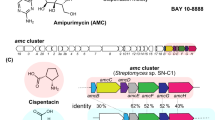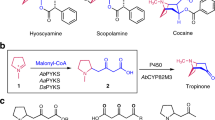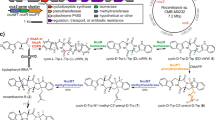Abstract
Metabolic diversity is being studied intensively by evolutionary biologists, but so far there has been no comparison of biosynthetic pathways leading to a particular secondary metabolite in both prokaryotes and eukaryotes. We have detected the bioactive anthraquinone chrysophanol, which serves as a chemical defense in diverse eukaryotic organisms, in a bacterial Nocardia strain, thereby permitting the first comparative biosynthetic study. Two basic modes of folding a polyketide chain to fused-ring aromatic structures have so far been described1: mode F (referring to fungi) and mode S (from Streptomyces). We have demonstrated that in eukaryotes (fungi, higher plants and insects), chrysophanol is formed via folding mode F. In actinomycetes, by contrast, the cyclization follows mode S. Thus, chrysophanol is the first polyketide synthase product that is built up by more than one polyketide folding mode.
This is a preview of subscription content, access via your institution
Access options
Subscribe to this journal
Receive 12 print issues and online access
$259.00 per year
only $21.58 per issue
Buy this article
- Purchase on Springer Link
- Instant access to full article PDF
Prices may be subject to local taxes which are calculated during checkout




Similar content being viewed by others
References
Thomas, R. A biosynthetic classification of fungal and streptomycete fused-ring aromatic polyketides. ChemBioChem 2, 612–627 (2001).
Bringmann, G., Wohlfarth, M., Rischer, H., Rückert, M. & Schlauer, J. The polyketide folding in the biogenesis of isoshinanolone and plumbagin from Ancistrocladus heyneanus (Ancistrocladaceae). Tetrahedr. Lett. 39, 8445 (1998).
Bringmann, G., Wohlfarth, M., Rischer, H., Grüne, M. & Schlauer, J. A new biosynthetic pathway to alkaloids in plants: acetogenic isoquinolines. Angew. Chem. Int. Edn. Engl. 39, 1464–1466 (2000).
Thomson, R.H. Naturally occurring quinones III 383 (Chapman and Hall, New York, 1987).
Howard, D.F., Phillips, D.W., Jones, T.H. & Blum, M.S. Anthraquinones and anthrones: occurrence and defensive function in a chrysomelid beetle. Naturwissenschaften 69, 91–92 (1982).
Hilker, M. & Schulz, S. Anthraquinones in different development stages of Galeruca tanaceti (Coleoptera: Chrysomelidae). J. Chem. Ecol. 17, 2323 (1991).
Hilker, M., Eschbach, U. & Dettner, K. Occurrence of anthraquinones in eggs and larvae of several Galerucinae (Coleoptera: Chrysomelidae). Naturwissenschaften 79, 271 (1992).
Kunze, A., Witte, L., Aregullin, M., Rodriguez, E. & Proksch, P. Anthraquinones in the leaf beetle Trirhabda geminata (Chrysomelidae). Z. Naturforsch. [C] 51, 249–252 (1996).
Mishchenko, N.P., Stepanenko, L.S., Krivoshchekova, O.E. & Maksimov, O.B. Anthraquinones of the lichen Asahinea chrysantha. Him. Prir. Soedin. 2, 160–165 (1980).
Krivoshchekova, O.E., Stepanenko, L.S., Mishchenko, N.P., Denisenko, V.A. & Maksimov, O.B. Study of lichens from the Parmeliaceae family. II. Pigments. Him. Prir. Soedin. 3, 283–289 (1983).
Fotso, S. et al. Bhimamycin A∼E and bhimanone: isolation, structure elucidation and biological activity of novel quinone antibiotics from a terrestrial streptomycete. J. Antibiot. 56, 931–941 (2003).
Funa, N. et al. A new pathway for polyketide synthesis in microorganisms. Nature 400, 897–899 (1999).
Yagi, A., Makino, K. & Nishioka, I. Constituents of Aloe saponaria. I. Structures of tetrahydroanthracene derivatives and the related anthraquinones. Chem. Pharm. Bull. (Tokyo) 22, 1159–1166 (1974).
Bartel, P.L. et al. Biosynthesis of anthraquinones by interspecies cloning of actinorhodin genes in streptomycetes: clarification of actinorhodin gene functions. J. Bacteriol. 172, 4816–4826 (1990).
Leistner, E. & Zenk, M. Chrysophanol (1,8-dihydroxy-3-methylanthraquinone) biosynthesis in higher plants. J. Chem. Soc. Chem. Commun. 210–211 (1969).
Fairbairn, J.W. & Muhtadi, F.J. Biosynthesis and metabolism of anthraquinones in Rumex obtusifolius. Phytochemistry 11, 215–219 (1972).
Leistner, E. Second pathway leading to anthraquinones in higher plants. Phytochemistry 10, 3015–3020 (1971).
Ahmed, S.A., Bardshiri, E. & Simpson, T.J. A convenient synthesis of isotopically labeled anthraquinones, chrysophanol, islandicin, and emodin. Incorporation of [methyl-2H3]chrysophanol into tajixanthone in Aspergillus variecolor. J. Chem. Soc. Chem. Commun. 883–884 (1987).
Van Eijk, G.W. Chrysophanol and emodin from Drechslera catenaria. Phytochemistry 13, 650 (1974).
Bax, A., Freeman, R. & Frenkiel, T.A. An NMR technique for tracing out the carbon skeleton of an organic molecule. J. Am. Chem. Soc. 103, 2102–2104 (1981).
Berger, S. Selective INADEQUATE. A farewell to 2D-NMR? Angew. Chem. Int. Edn. Engl. 27, 1196–1197 (1988).
Bringmann, G., Noll, T. & Rischer, H. In vitro germination and establishment of tissue cultures of Bulbine caulescens and of two Kniphofia species (Asphodelaceae). Plant Cell Rep. 21, 125–129 (2002).
Styles, P. & Stoffe, N.F. A high-resolution NMR probe in which the coil and preamplifier are cooled with liquid helium. J. Magn. Reson. 60, 397–404 (1984).
Fiedler, H-P. Biosynthetic capacities of actinomycetes. 1. Screening for new secondary metabolites using UV-visible absorbance spectral libraries. Nat. Prod. Lett. 2, 119–128 (1993).
Agarwaj, S.K., Singh, S.S., Verma, S. & Kumar, S. Antifungal activity of anthraquinone derivatives from Rheum emodi. J. Ethnopharmacol. 72, 43–46 (2000).
Semple, S.J., Pyke, S.M., Reynolds, G.D. & Flower, R.L.P. In vitro antiviral activity of the anthraquinone chrysophanic acid against poliovirus. Antiviral Res. 49, 169–178 (2001).
Hilker, M. & Köpf, A. Evaluation of the palatability of chrysomelid larvae containing anthraquinones to birds. Oecologia 100, 421–429 (1995).
Goodfellow, M., Isik, K. & Yates, E. Actinomycete systematics: an unfinished synthesis. Nova Acta Leopold. 312, 47–82 (1999).
Acknowledgements
This work is dedicated to Burchard Franck on the occasion of his 80th birthday. Financial support from the Fonds der Chemischen Industrie, the European Commission (grant QLK3-CT-2001-01783; project ACTAPHARM), and the German Research Foundation (DFG Hi 416/16-2) are gratefully acknowledged. We thank D. Moskau (Bruker Biospin AG, Fällanden, Switzerland) for the acquisition of a 2D INADEQUATE spectrum with a cryoprobe and F. Meyer for technical support.
Author information
Authors and Affiliations
Corresponding author
Ethics declarations
Competing interests
The authors declare no competing financial interests.
Rights and permissions
About this article
Cite this article
Bringmann, G., Noll, T., Gulder, T. et al. Different polyketide folding modes converge to an identical molecular architecture. Nat Chem Biol 2, 429–433 (2006). https://doi.org/10.1038/nchembio805
Received:
Accepted:
Published:
Issue Date:
DOI: https://doi.org/10.1038/nchembio805
This article is cited by
-
Endophytic association of bioactive and halotolerant Humicola fuscoatra with halophytic plants, and its capability of producing anthraquinone and anthranol derivatives
Antonie van Leeuwenhoek (2020)
-
New bhimamycins from Streptomyces sp. AK 671
The Journal of Antibiotics (2013)
-
Anticancer potential of Himalayan plants
Phytochemistry Reviews (2011)
-
Functional molecules from natural sources: Organized by the Royal Society of Chemistry Biotechnology Group, Magdalen College, Oxford, UK, 6–8 July 2009
The Journal of Antibiotics (2009)
-
Acetogenic anthraquinones: biosynthetic convergence and chemical evidence of enzymatic cooperation in nature
Phytochemistry Reviews (2008)



